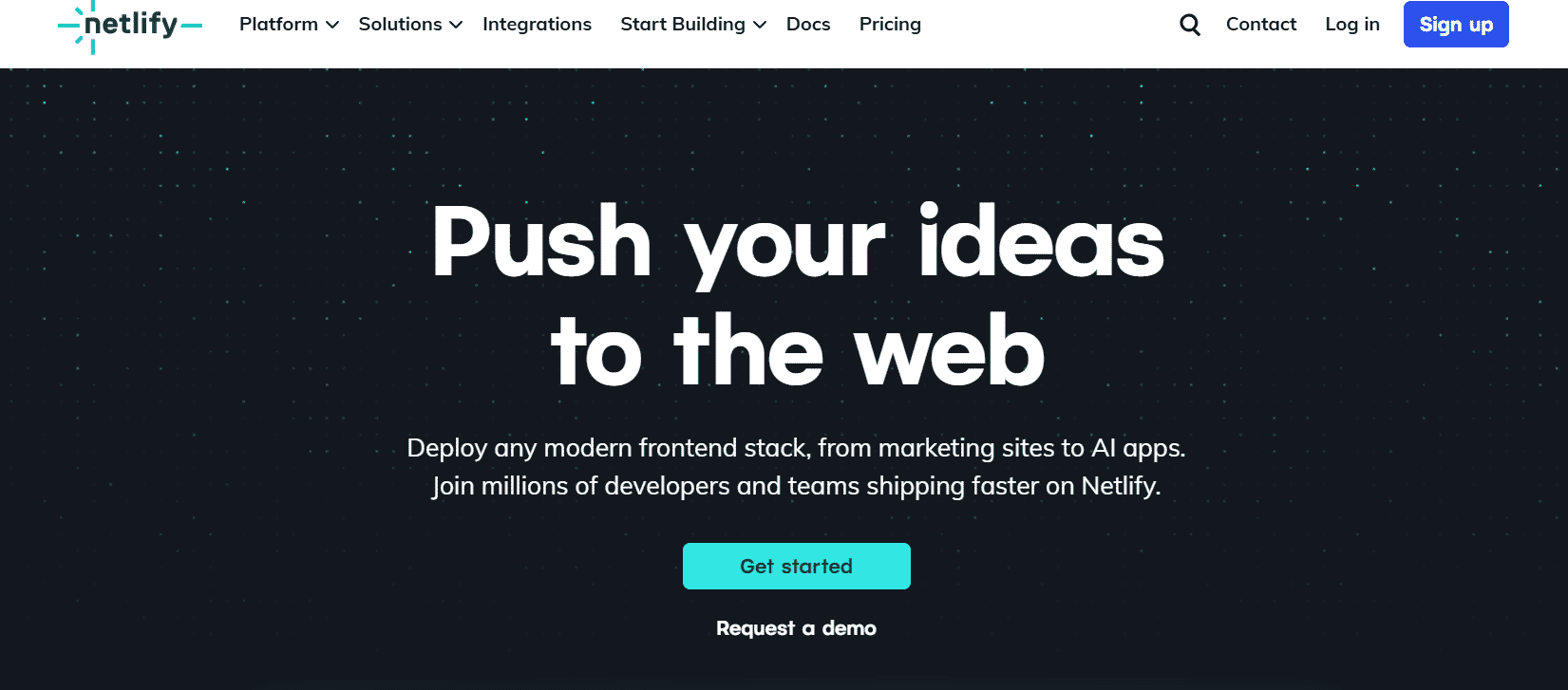In today's fast-paced web development ecosystem, choosing the right deployment platform can significantly impact your application's performance, scalability, and your team's workflow efficiency. While Vercel has gained immense popularity for its seamless integration with Next.js and other frontend frameworks, the deployment landscape offers numerous compelling alternatives worth exploring.
This blog post dives into five robust deployment platforms that provide powerful features and capabilities that might better suit your specific project requirements.
1. Netlify: The Developer Experience Champion
Netlify has established itself as a formidable deployment platform with a focus on developer experience and intuitive workflows. It's particularly well-suited for JAMstack applications but versatile enough for various web projects.
Key Features:
- Continuous Deployment: Automatic builds from Git repositories with branch and preview deployments
- Serverless Functions: Built-in support for AWS Lambda functions without additional configuration
- Edge Network: Global CDN with intelligent caching for optimal performance
- Forms Handling: Native form processing without requiring a backend server
- Split Testing: Simple A/B testing capabilities for different deployment branches
Why Choose Netlify?
Netlify excels in providing a complete platform for frontend teams looking to deploy static sites and serverless functions with minimal setup. Its developer-focused approach, with features like deploy previews for pull requests and easy rollbacks, makes it particularly valuable for teams that prioritize collaboration and rapid iteration.
2. Railway: The Full-Stack Developer's Dream
Railway has emerged as a developer-friendly platform designed to simplify full-stack application deployment. Unlike platforms focused primarily on frontend deployments, Railway handles everything from databases to services with remarkable ease.
Key Features:
- One-Click Deployments: Deploy directly from GitHub with minimal configuration
- Integrated Databases: Native support for PostgreSQL, MySQL, MongoDB, and Redis
- Private Networking: Secure communication between services without exposing ports
- Environments: Separate development, staging, and production environments
- Usage-Based Pricing: Pay only for what you use with transparent pricing
Why Choose Railway?
Railway shines when you need to deploy both frontend and backend components with integrated databases. Its approach eliminates much of the DevOps complexity traditionally associated with deploying full-stack applications, making it ideal for small to medium-sized teams that want to focus on development rather than infrastructure management.
3. Render: The Balanced Approach
Render offers a compelling middle ground between traditional cloud providers and PaaS solutions. It provides enough flexibility without overwhelming users with configuration options.
Key Features:
- Blueprint Infrastructure: Define your entire stack in a single file
- Native Services: Support for web services, static sites, background workers, and cron jobs
- Managed Databases: Automated backups, scaling, and high availability for PostgreSQL
- Private Networks: Secure communication between your services
- Zero Downtime Deployments: Keeps your application available during updates
Why Choose Render?
Render is particularly well-suited for teams transitioning from simple deployments to more complex architectures. It offers many advanced features of traditional cloud providers but with significantly less configuration overhead. The platform strikes an excellent balance between simplicity and flexibility, making it appropriate for growing applications.
4. Fly.io: The Global Edge Computing Platform
Fly.io takes a unique approach by deploying applications to a global network of compute servers close to your users. This edge-computing focus provides exceptional performance benefits for applications with global audiences.
Key Features:
- Global Deployment: Run your application in multiple regions worldwide
- Edge Computing: Process requests close to users for minimal latency
- Persistent Volumes: Stateful applications with persistent storage
- Private Networking: Secure VM-to-VM communication across regions
- HTTP/2 and HTTP/3: Modern protocol support for optimal performance
Why Choose Fly.io?
Fly.io stands out for applications that require global presence and low latency. Its VM-based architecture provides more flexibility than typical serverless platforms while maintaining simplicity. It's particularly suitable for data-intensive applications, APIs, and services that benefit from edge computing capabilities.
5. DigitalOcean App Platform: The Scalable Solution
DigitalOcean's App Platform brings the company's renowned simplicity to application deployment while providing a path to more advanced infrastructure as your needs evolve.
Key Features:
- Containerized Deployments: Built on Kubernetes without the complexity
- Managed Databases: Integrated PostgreSQL, MySQL, MongoDB, and Redis services
- Horizontal Scaling: Easily scale your application as demand grows
- Global CDN: Integrated content delivery network for static assets
- Smooth Upgrade Path: Seamless transition to Kubernetes if you outgrow the platform
Why Choose DigitalOcean App Platform?
DigitalOcean App Platform is ideal for teams that anticipate significant growth and want a deployment solution that can scale with them. It provides a gentle introduction to container-based deployments with the option to transition to more advanced infrastructure as requirements evolve. The transparent pricing model also makes it popular among startups and small businesses.
Making the Right Choice for Your Project
When evaluating these platforms against Vercel, consider these factors:
- Project Architecture: Full-stack applications might benefit more from Railway or Render than purely frontend-focused platforms.
- Team Expertise: Some platforms require more DevOps knowledge than others. Choose based on your team's strengths.
- Scaling Requirements: Consider not just your current needs but where your application might be in 12-24 months.
- Budget Constraints: Pricing models vary significantly between platforms. Some offer generous free tiers, while others provide better economics at scale.
- Integration Requirements: Consider how the platform integrates with your existing tools and workflows.
Each of these platforms offers unique advantages that might make them a better fit than Vercel for your specific requirements. By looking beyond the most popular options and evaluating alternatives based on your project's specific needs, you can find a deployment platform that truly enhances your development workflow and application performance.
Remember, the best deployment platform isn't necessarily the most popular one—it's the one that aligns most closely with your project requirements, team capabilities, and future growth plans.
What deployment platforms are you currently using? Have you tried any of the alternatives mentioned in this article? Share your experiences in the comments below!
